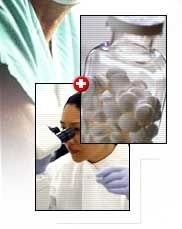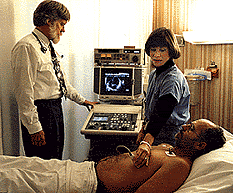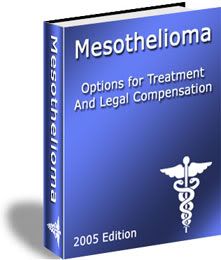Smoking Cessation.
Efficacy and Safety of the Novel Selective Nicotinic Acetylcholine Receptor Partial Agonist, Varenicline, for Smoking Cessation.
TOBACCO USE CAUSES CANcer, heart disease, chronic obstructive pulmonary disease, and premature death. More than one third of the world's population older than 15 years smokes, making tobacco addiction the leading cause of preventable death worldwide. Although currently available therapies can help some smokers quit, their efficacy is modest. Therefore, development of new therapies to treat tobacco dependence is crucial.
Varenicline tartrate represents the first nicotinic acetylcholine receptor partial agonist to be developed specifically for smoking cessation. A partial agonist has lower intrinsic efficacy than a full agonist and may act as an antagonist by competing with an agonist for receptor binding. Varenicline is highly selective for the [alpha]4[beta]2 nicotinic acetylcholine receptor, which is responsible for mediating the reinforcing properties of nicotine in the brain. As a partial agonist with higher affinity and less functional effect than nicotine, varenicline may alleviate craving and withdrawal during smoking cessation. With nicotine exposure, the receptor occupancy of varenicline would be expected to block the reinforcing effects of smoking. This may lead to an extinction of smoking behavior prior to a quit attempt and prevent a slip from becoming a relapse after a quit attempt.
Varenicline tartrate is well tolerated in doses up to 3 mg/d. Nausea, a common adverse experience, is reduced when varenicline is divided into 2 doses rather than administered as a single dose. The primary objective of this study was to evaluate the efficacy and safety of 4 varenicline tartrate dose regimens (0.5 mg and 1.0 mg twice daily; titrated and nontitrated) for smoking cessation. A secondary objective was to evaluate the effects of dose titration on nausea and overall tolerability.
COMMENT
In this study, treatment with varenicline tartrate at doses of 0.5 mg and 1.0 mg twice daily, was associated with significantly higher smoking cessation rates compared with placebo. Varenicline reduced craving and the reinforcing effects of smoking. Varenicline was generally well tolerated, and nausea was a frequent adverse event. Titration during the first week of treatment appeared to reduce the incidence of nausea.
The pooled analyses for the 0.5- and 1.0-mg groups demonstrate quit rates of approximately 4 times that observed with placebo during weeks 9 through 12 and at the 1-year follow-up. Interestingly, the continuous quit rate for each varenicline dose regimen increased from weeks 4 to 7 to weeks 9 to 12. A similar pattern was observed with the 7-day point prevalence quit rates. When administered for 12 weeks, other smoking cessation pharmacotherapies demonstrate a decrease in abstinence rates or a stabilization of abstinence rates during the latter part of medication treatment. Since quit rates appear to increase with continued varenicline treatment, repeated quit attempts with treatment and a longer treatment duration may be beneficial. Moreover, since many subjects relapsed between weeks 12 and 24, future research should examine whether a longer treatment with varenicline and/or continuation of behavioral counseling also reduces smoking relapse.
The novel mechanism of action of varenicline may be responsible for the relatively high quit rates compared with placebo and the relative increase in quit rates over the medication treatment period. The agonist properties of varenicline may alleviate craving and withdrawal during smoking cessation. Each varenicline tartrate pooled dosage group significantly reduced craving compared with placebo at each weekly visit during the study. Moreover, varenicline reduced the reinforcing effects of smoking (ie, smoking satisfaction, psychological reward, and enjoyment of respiratory tract sensations), which suggests a clinical response to the antagonistic properties of the medication.
Varenicline has an acceptable safety and tolerability profile. The higher rate of completion in the varenicline groups vs placebo group suggests perceived benefit to the subject. Although discontinuation of study medication owing to adverse events was highest in the 1.0-mg twice-daily titrated group (21.7%), this rate was comparable to placebo (17.4%). It seems likely that most of the adverse effects are drug related; however, it is possible that some of the adverse events in the placebo and varenicline groups were signs and symptoms of tobacco withdrawal and were more frequent in the varenicline groups because of higher smoking cessation rates. The basis is unclear for the finding that discontinuation of treatment owing to an adverse event appeared to be greater in the titrated vs nontitrated groups, especially since the incidence rates of adverse events did not follow a similar pattern. Very few subjects discontinued medication because of nausea. The incidence of nausea was consistent with the pharmacologic effects of cholinergic agents and could be centrally or locally mediated. Our results suggest that nausea is dose related and that titration reduced the incidence of nausea.
A limitation of the study is the optional follow-up study design. Subjects who abstained from smoking during weeks 9 through 12 and who did not enter the follow-up phase were counted as smokers, which may have lowered the true long-term efficacy rates (particularly in the 0.5-mg twice-daily group). However, even if the subjects who did not enter the follow-up truly remained abstinent from smoking at 1 year, this would have underestimated the true long-term quit rate by only 4% in the 0.5-mg twice-daily group, 1.5% in the 1.0-mg twice-daily group, and 2.3% in the placebo group. Since approximately 90% of subjects who completed treatment continued in the follow-up phase, the analyses conducted likely represents a reasonable estimation of long-term quit rates.
In summary, varenicline tartrate (0.5-mg and 1.0-mg doses taken twice daily for 12 weeks) significantly improved short- and long-term abstinence rates compared with placebo. Titration of the drug over the first week reduced the incidence of nausea. Future studies are warranted to compare the efficacy of varenicline to other smoking cessation pharmacotherapies and to determine whether a longer duration of medication treatment improves smoking cessation rates.
Conclusion
Varenicline tartrate, 0.5 mg and 1.0 mg twice daily, is efficacious for smoking cessation.




1 Comments:
Why Me
Are you tired of hearing those words. Are you tired of your boss and the people at your work . Looking for a opportunitiy to real home based business opportunity. then visit http://homebusiness.opportunitiesinfo.com
Post a Comment
<< Home